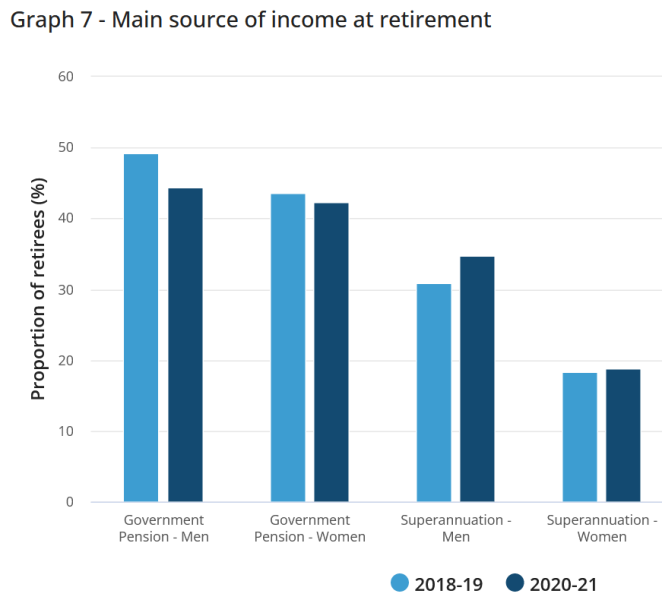Why Australians are choosing to work longer and retire later


Australians are working longer and enjoying it. Photo: Getty
Australians are retiring later and there appears to be no plans to change that in coming decades.
New research from consultants KPMG has found that in 2022 and 2023 the expected retirement age for men was 66.2 and 64.8 for women.
Those figures are the highest since 1972 and 1971, respectively.
ABS research has found there will be little change in that in the longer term, with both men and women expected to retire at 66 as far ahead as 2041.
Despite the growth of superannuation and general levels of wealth, the retirement age over the past two decades has been steadily increasing from 63.3 for men and from 61.6 for women.
Changes in the economy with the growth of white-collar employment has been a major driver of the trend.
The experience of many during the Covid pandemic has also contributed.
Chris Grice, CEO of National Seniors Australia, said he was not surprised by KPMG’s findings which were in part driven by the increase of the age pension eligibility age to 67 from 65 in recent years and rising living costs in retirement.
Changing expectations
“It is also due to expectations changing as a result of people’s desire to remain in the workforce for non-financial reasons, such as social connection and identity,” Grice said.
Changes in work arrangements during Covid is also a factor.
“The adoption of working from home has made many older Australians in professional jobs realise that they could ‘semi-retire’ and continue to dabble in the workforce from home or even from a coastal location,” KPMG urban economist Terry Rawnsley said.
The effect of the pandemic years in motivating people to work longer is also evident in KPMG’s research.
Between 2019 and 2021, the Australian labour force increased by 185,000 people.
And almost 70 per cent of that growth (or about 127,000 people) was made up of those aged 55 and above.
That older cohort filled shortfalls in the labour market when international migration dried up.
However, with the return of international migration and the resulting lift in the under-55 labour force, the share of over-55s fell to 21.3 per cent in 2023, KPMG found.
Women work more
Since the onset of the pandemic, women have been increasingly drawn into full-time employment.
But the growth in retirement age for men has been driven by increases in older men working part time, KPMG found.
There are a number of reasons for the increase in retirement ages.
For those relying largely on the pension, the age pension retirement age has increased from 65 to 67 in recent years.
Cost-of-living increases and the government work bonus, which allows people to work in retirement and not reduce their pension entitlements, are factors.
The work bonus allows a person on a full or part pension to earn up to $300 per fortnight from paid employment without affecting the pension income test.
An attractive feature is that it also allows the banking of up to $11,800 against future earnings, a figure that has no carry-forward time limit.
The move to longer working lives is not simply about financial needs because a growing number of people are enjoying more superannuation income in retirement.
ABS figures in the table above demonstrate that reliance on the age pension as the major source of retirement income has fallen in recent years.
Back in 2018-19, 49.2 per cent of men and 43.6 per cent of women relied on the age pension for most of their retirement income.
However, in those years reliance on superannuation for the bulk of retirement income increased from 30.8 per cent to 34.7 per cent for men and 18.3 per cent to 18.7 per cent for women.
That suggests both men and women are becoming more prosperous in old age, having superannuation to boost age pension entitlements.
Although those relying on the pension and perhaps a little super are mainly driven to work more by financial needs, those with higher socioeconomic status are more likely to work to meet non-financial needs, Grice said.
Lifestyle factors
Some people aspire to retire fully when young enough to enjoy life, but others choose a transition to retirement through part-time work.
“This latter group are looking for employment opportunities that are flexible and meet their skills and interests,” Grice said.
Although there is a move for older people to work longer, employers and governments should not view that phenomenon as ongoing.
“Even in a tight labour market, we may have reached a plateau in the expected age of retirement, suggesting we cannot expect older workers to continue working longer,” Rawnsley said.
Recent research by Treasury revealed the number of Australians aged 65 and over will more than double, and the number aged 85 and over will more than triple over the next 40 years.
The number of centenarians is expected to increase six-fold in that time.
The New Daily is owned by Industry Super Holdings









